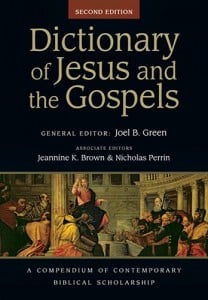 When I sketched the original post announcing the release of the 2nd edition of the Dictionary of Jesus and the Gospels, I thought I would begin the comparison with Matthew. However, I found my interest drew me first to the article on the “Quest of the Historical Jesus”. I’ve used the article to good effect in my own study as well as in classes. So it is one I knew fairly well. This article is an interesting case study in the difference between the two editions because it was authored by the same person, Collin Brown. As some readers may have noticed in the comment from Richard Bauckham to the previous post on the DJG, Richard noted that while he was an original contributor, he was not asked to write the article for the same topic in the 2nd edition (“Gospels [Apocryphal]” in the 1st ed, “Christology” in the 2nd).
When I sketched the original post announcing the release of the 2nd edition of the Dictionary of Jesus and the Gospels, I thought I would begin the comparison with Matthew. However, I found my interest drew me first to the article on the “Quest of the Historical Jesus”. I’ve used the article to good effect in my own study as well as in classes. So it is one I knew fairly well. This article is an interesting case study in the difference between the two editions because it was authored by the same person, Collin Brown. As some readers may have noticed in the comment from Richard Bauckham to the previous post on the DJG, Richard noted that while he was an original contributor, he was not asked to write the article for the same topic in the 2nd edition (“Gospels [Apocryphal]” in the 1st ed, “Christology” in the 2nd).
I still intend to write a post on the “Matthew” article as it will illustrate, on the other hand, the difference between the two editions by looking at an article written by different scholars in the 1st and 2nd editions.
Historical Jesus, Quest of -vs- Quest of the Historical Jesus
I begin with some data:
1. Title
- 1st edition: “Historical Jesus, Quest of”
- 2nd edition: “Quest of the Historical Jesus”
2. Length
- 1st edition: Covered 32 columns of text over 15 pages (326-41)
- 2nd edition: Covered 78 columns over 38 pages (718-56)
3. Author: Both written by Collin Brown
4. Table of contents
- 1st edition
- The Original Quest (1778-1906)
- From the History of Religions School to the New Quest
- The Third Quest
- Conclusion
- 2nd Edition
- The Quest for the Theological Jesus
- Quests Before the Quest
- Schweitzer’s Quest in Context
- From Harnack to Grundmann
- From Bousset to Bultmann and the “New Quest”
- European Alternatives
- The English-Speaking World
- The Ongoing Quest
- Concluding Reflections
5. Bibliography
- 1st edition: one column 6 inches
- 2nd edition 9 columns 70 inches
From just a survey of these data one can see that the article in the second edition of the DJG is a completely new and much expanded article. While no doubt including much of the material in the first it has been reshaped and presented along with a significant amount of additional material. There is also a different perspective offered in the second edition, more skeptical of the labels used to describe the Quests and more focus on the theological element (the addition of the section “The Quest for the Theological Jesus”). One sees this at the very first, where Brown begins with a skepticism about the labels given to the Quests. He attributes this more to the “enterprising spirit of British publishers”. Such skepticism was absent in the first edition’s article.
This is surely one of the most thorough, if not the most thorough, surveys of the history of the quest for the historical Jesus written in a brief pamphlet-like size. I challenge anyone to find something that tops it for its concision and completeness. Not only is it analytically and critically rich (note the criticism of Tom Wright’s Jesus and the Victory of God), but it discusses most all the key figures in the history of research. Looking at the bibliography it appears there are plans to turn the article into a separate book published by IVP called The Quests of the Historical Jesus: A Brief History. I will look forward to this book which will be an excellent companion in a course on Jesus.
While Brown couldn’t cover every one who has written on the subject of the historical Jesus—surprisingly there’s no mention of my monumental article “Presuppositions and Procedures in the Study of the ‘Historical Jesus’ Or Why I’m not a Historical Jesus Scholar?” (JSHJ 3.1 (2005): 61-108)—I am surprised the work of the late Sean Freyne has no place in his survey (The Twelve: Disciples and Apostles: A Study in the Theology of the First Three Gospels. London & Sydney: Sheed & Ward, 1968; Galilee from Alexander the Great to Hadrian, 323 B.C.E. to 135 C.E.: A study of Second Temple Judaism. Edinburgh: T & T Clark, 1980; Galilee, Jesus, and the Gospels: Literary Approaches and Historical Investigations. Dublin: Gill and Macmillan, 1988; Galilee and Gospel: Collected Essays. Vol. 125, WUNT. Tübingen: Mohr Siebeck, 2000; “The Geography of Restoration: Galilee–Jerusalem Relations in Early Jewish Christian Experience.” NTS 47 (2001): 289-311; Jesus, A Jewish Galilean: A New Reading of the Jesus-Story. London: T & T Clark International, 2004). Freyne’s important contributions should not have been overlooked.
The article on the “Quest of the Historical Jesus” is not simply revision of the first edition. It is a new article. And it exceeds the first edition significantly.










